- Home
- Camino Portugués
- Day Four, Santarem to Golega
Jump to Camino Portugués Stages
Day Four on the Camino Portugués
~ Santarém to Golegã , 30.9 Km (19.2 Miles)
Day four on the Camino Portugués is essentially a walk through God's wine country, from one farm village to another, navigating the pilgrimage traveler on old and rough tractor lanes between fields. This is a long, hot and dry stage, so plan your day accordingly!
"Contemplative walking is Gros’s
favored kind: the walking of medieval pilgrims, of Jean-Jacques Rousseau and
Henry David Thoreau, of Kant’s daily life. It is the Western equivalent of what
Asians accomplish by sitting. Walking is the Western form of meditation: 'You’re doing nothing when you walk, nothing but walking. But having nothing to
do but walk makes it possible to recover the pure sensation of being, to
rediscover the simple joy of existing, the joy that permeates the whole of
childhood.' ” ~ an excerpt from the New Yorker article, "Heaven's Gates" by Adam Gopnik, on Frederic Gros's book, "A Philosophy of Walking."
Map and Stats of Day Four on the Camino Portugués
Here is the Google Map from GPS recordings which I uploaded to Google Maps. I included accommodations, grocery stores and cafés along the way.
While we did the full, traditional stage, you can easily break this stage and stay in Azinhaga. (Click here for accommodations on Booking.com). There is also the option of staying in the Albergue de Peregrinos de Azinhaga, right along the route, just shy of 8 kilometers from Golegã (pronounced gole as in "pole" - ga).
For information’s sake, I included on the map, in red, the old route through Pombalinho (pronounced Pōm-ba-LEEN-yo), a full 3.6 kilometers longer. I really don’t know why anyone would desire to take this route now, unless your destination was to one of the accommodations just east of Pombalinho. There is not even a café there anymore.
Here is the elevation profile for our day. It is a nice downhill slide from the top of the hill in Santarém to the river valley, followed by a slow, steady climb to Vale de Figueira, and the remainder of the day essentially flat.
Camino Portugués eBook Guides
Our Downloadable Camino Portugués eBook Guides in PDF Format contain all the valuable information from our web pages, for comfortable reading offline and without ads on your personal device. Don't carry a hard copy guide book to increase your pack weight. Use our digital guides on your next Camino instead!
Our ebook guides are packed with frequently updated information, because a digital format is more nimble than hard-copy publishing. Our eBook Guide is unique because we also entertain and immerse you with our story! Click on any eBook above for more information.
Buy only what you need OR buy ALL FOUR eBooks for the price of THREE - a 25% savings! Click here for more information or BUY NOW at only 17.85!
Jump to Camino Portugués Stages
Photo-Rich Travelogue of Day Four on the Camino Portugués
We didn't start out until 8:00 a.m. on day four, due to our hotel serving an amazing and huge breakfast at 7:00 a.m., complete with cold meat and cheese. It was a lovely start to our day, even if we did get a late start. If you are in the albergue or a place that does not serve breakfast, you may want to secure food the night before as very little is open in the early morning.
Beginning at this stage from where we left off on day three, from the northeast side of the main circle in the center of town, head eastward (right) and cross the plaza. (The large monastery looms to your left). Look for the easy-to-spot building across the street, below, with the Portas del Sol sign and a Camino waymark below it. Cross the street to the building and turn right onto the Av. Antonio dos Santos.
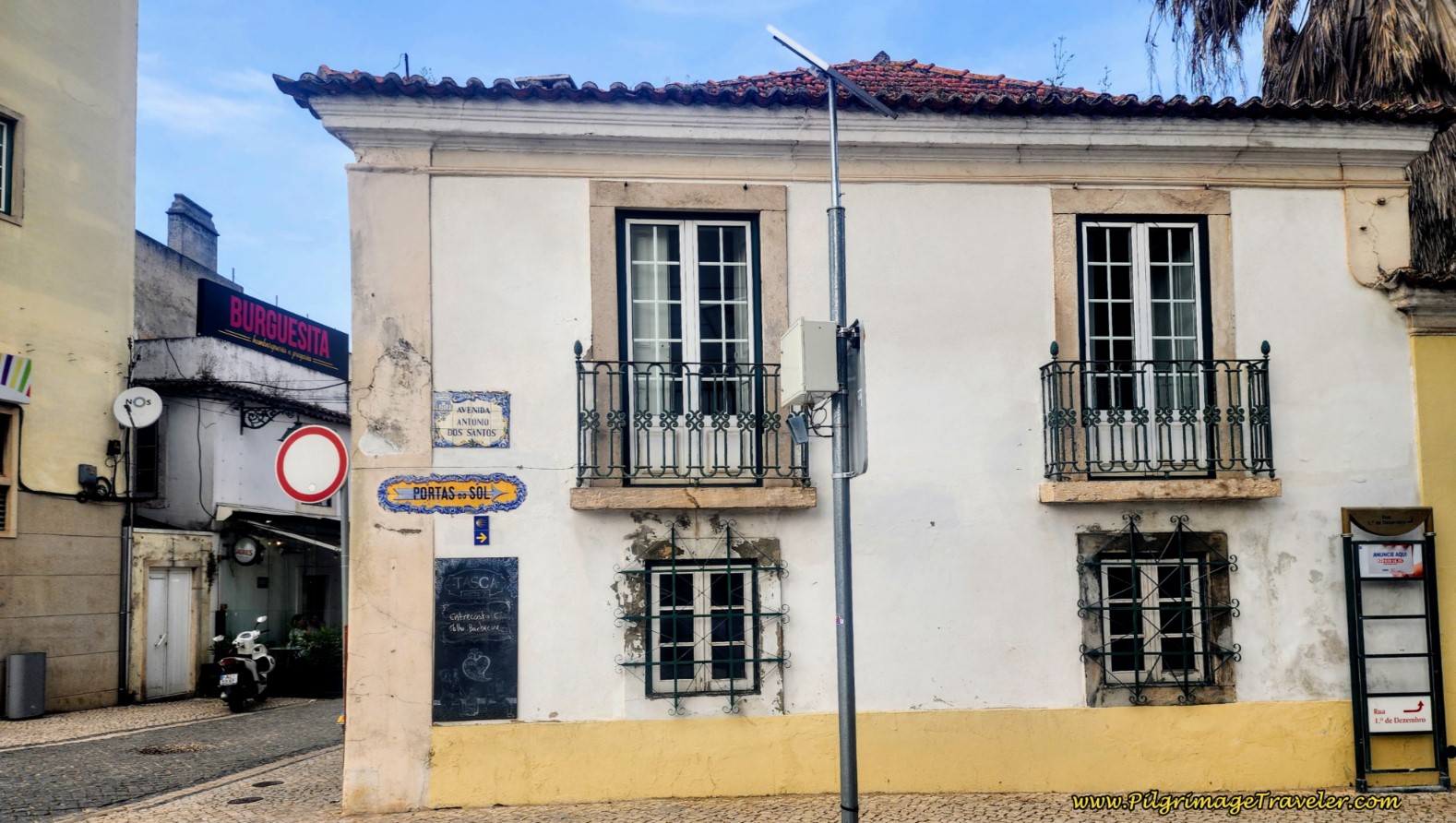 Right Turn onto Rua Joâo Afonso at this Building
Right Turn onto Rua Joâo Afonso at this BuildingOnly a few meters later, take the next left turn onto the Rua Joâo Afonso and continue in the direction of the Portas do Sol.
I loved the narrow cobblestone streets as we worked our way through town. Our Swiss friend, who we fondly called The Barnacle, since he loved to attach to us, was with us as we walked in the fresh, morning light. He was seemingly fit for the walk for the day, despite his blister.
 Along the Rua Joâo Afonso
Along the Rua Joâo AfonsoThe walk through Santarém is lovely, straightforward and well-marked with blue shell waymarks. You will pass by many churches as you walk through town.
The street changes names several times until it picks up the Av 5 de Outubro, bends to the right and makes the final approach to the Portas do Sol.
Just before you enter the Portas do Sol park, which you can see in the photo below, there is this intersection where you will turn left. Recently, I could find absolutely no Camino waymarks indicating this turn. Just beyond the parking kiosk that you see in the photo is a yellow and red waymark for a GR route, indicating a left turn also.
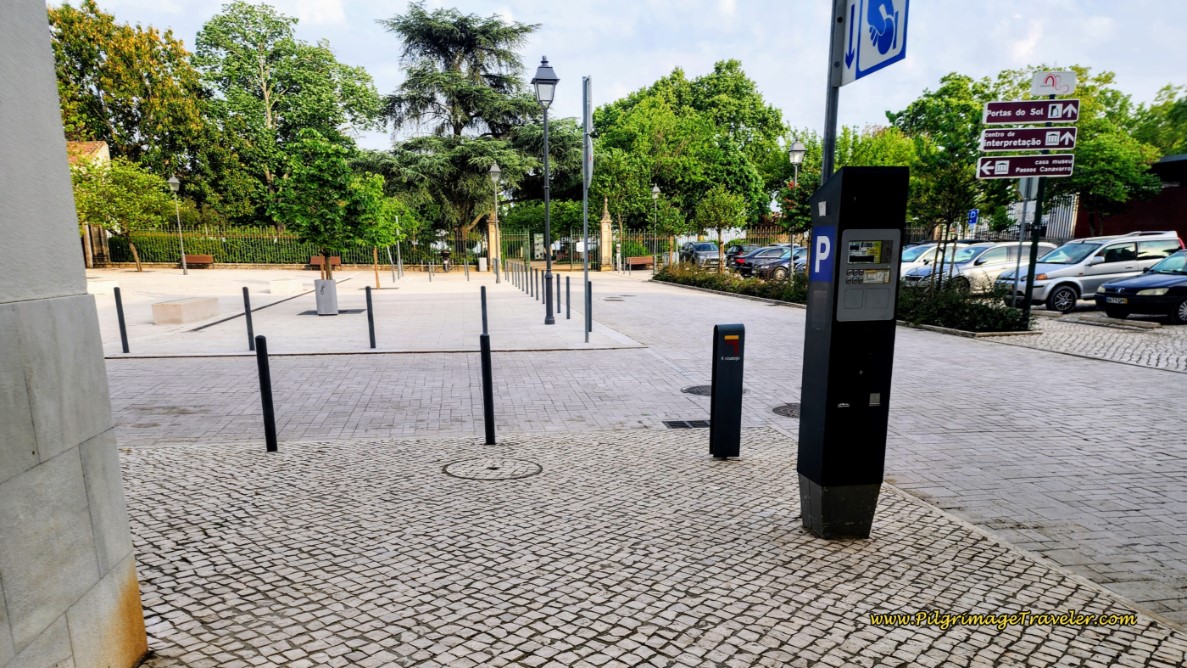 Turn Left Here, Before the Portas do Sol
Turn Left Here, Before the Portas do SolJust after the left turn, this road enters the plaza of the Igreja de Santa Maria de Alcáçova, shown next.
After only a few steps toward the church, there is a left turn again, onto the narrow Travessa de Santiago, seen in the photo above and facing the street, below. This turn is waymarked.
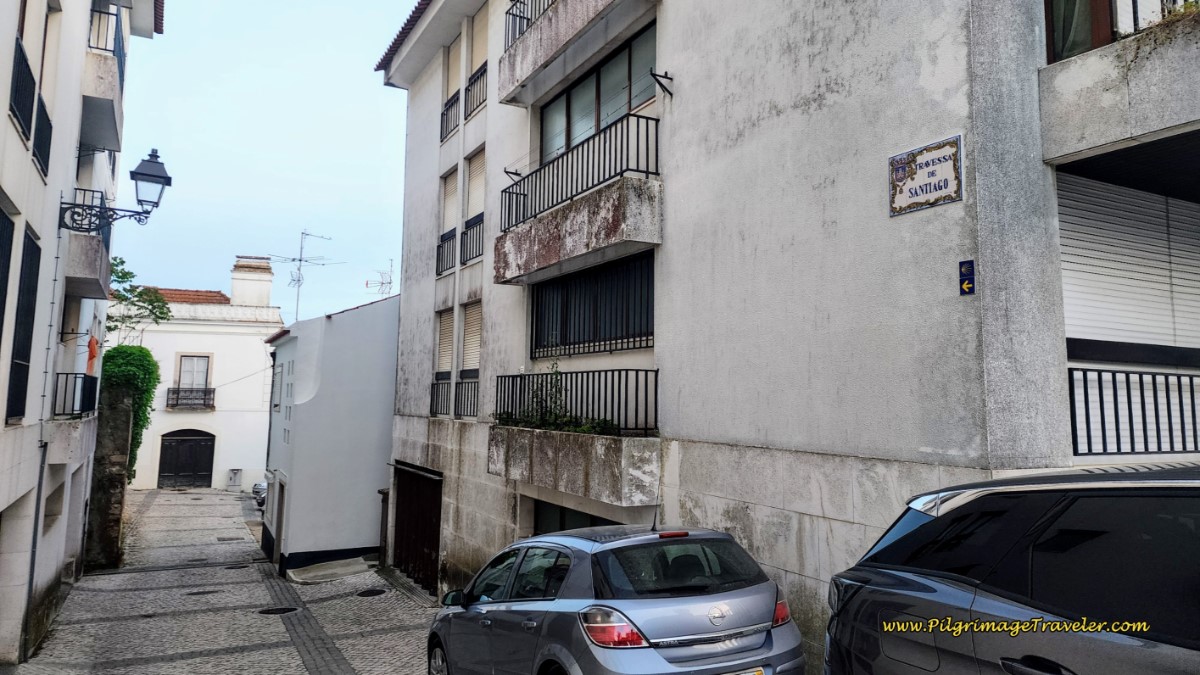 Left Turn onto Travessa de Santiago
Left Turn onto Travessa de SantiagoAt the end of this small street, about 50 meters later, there is an archway, below, appropriately called the Porta de Santiago (Santiago Gate). This is the medieval gate through the old town's fortress wall and is the way to go.
The onward road walks you along the outside of the fortress wall and down the hill. The Way is at first cobblestone, then after leaving the wall, it turns to a forest path.
The views over the valley from the top of the hill, on the path, used to be stunning, however the plants along the way are now overgrown and at times a tangled mess. In the photo below you can just about see the river in the valley floor below, if you squint.
Shortly, as the path snakes its way down the hilltop, it turns to the left, heading for the N114 and N365 below. While the photo shows a yellow arrow in the tree, this was all but gone our last time through. As long as you continue down the hill, you should be fine.
This forest path was such a lovely start to the day. And then suddenly, the path drops down and crosses the highway, the N114, and immediately goes to the left and onto the cobblestone N365, shown below. Make sure you stay on the lower road once you join the street, where the bright coral-colored Chalet Santa Iria greets you (not pictured).
 Walking the N365 into Ribeira de Santarém
Walking the N365 into Ribeira de SantarémFrom here, the N365 takes the pilgrimage traveler into the lower portion of Santarém, called Ribeira de Santarém, and you will walk through town, turning right onto the Rua do Meio, where a block later if you look hard left you will see a fountain and the street to the Casa da Ribeira (+351 243 092 143). Staying straight onward, cross train tracks next and join the Rua Alfageme de Santarém.
 Cross the Train Tracks on the Rua Alfageme de Santarém
Cross the Train Tracks on the Rua Alfageme de SantarémThere are two cafés in town that may open at 8am, one on the west side of town and the other just before the train tracks.
On the other side of the tracks, after a small diversion, the Camino turns left onto the Estrada de Alcôrse and by a historic fountain on the left, next turns right and across the bridge, the Ponte de Alcôrse, shown in the next two photos on day four of our Camino Portugués.
 Turn Right onto the Ponte Alcôrse
Turn Right onto the Ponte AlcôrseJump to Camino Portugués Stages
Beyond the bridge, after a short dirt lane, turn right to return to the pavement, crossing a small bridge. And then, the vineyards begin along the open road.
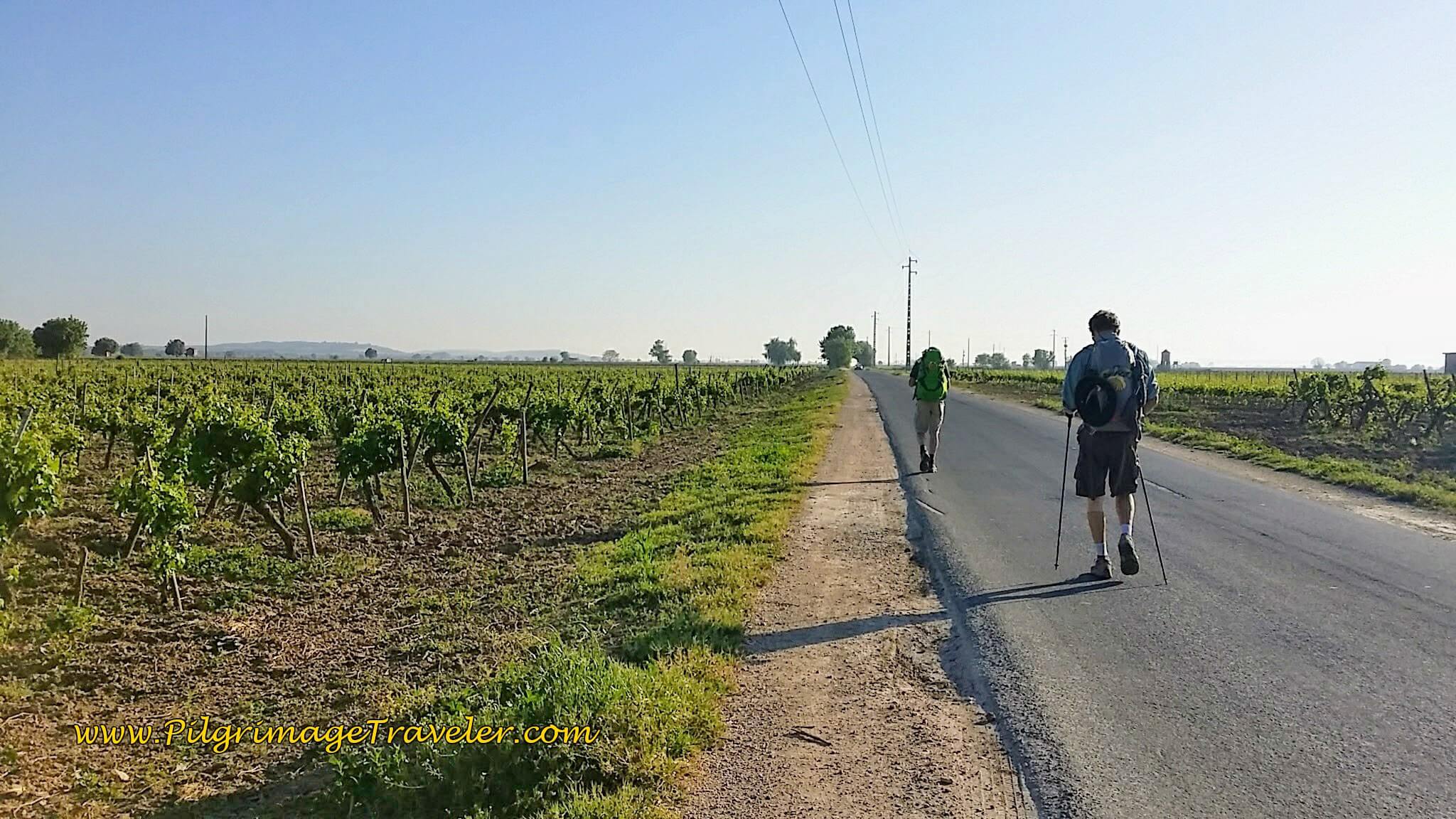 Vineyards Along the Open Road
Vineyards Along the Open RoadThe Camino turns left and onto a farmer's lane at this house after three kilometers into the day.
 Turn Left Here at House
Turn Left Here at HouseAfter 125 meters, a right turn onto another lane and then the Way turns into a more rugged farmer's lane. Looks like we are on a road to nowhere, in the photo below, doesn't it?
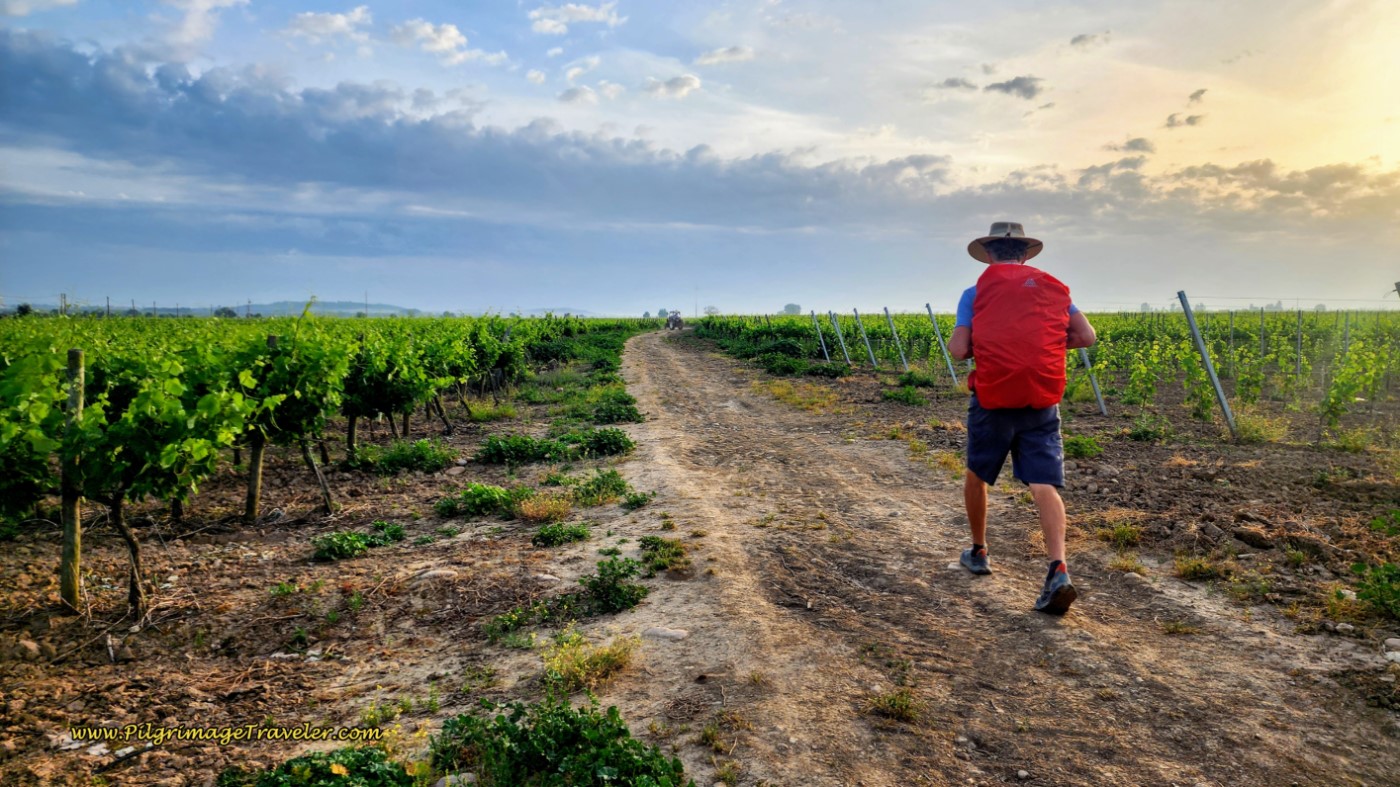 Rough Road Through Vineyards
Rough Road Through VineyardsA look back at Rich and our Swiss friend, with Santarém on the hill in the background. We were already putting some distance behind us.
After about 3.4 kilometers on the lane, and 6.4 kilometers total for the day, we joined the pavement briefly, below, only to turn right again immediately onto another farmer's lane, farther below.
 Brief Pavement, then the Camino Turns Right on Another Lane
Brief Pavement, then the Camino Turns Right on Another LaneThe vineyards were lovely, and seemingly endless!
A turn off the gravel road and once again, the rough farm lanes prevail.
 Turn Left Onto Rough Farm Lane
Turn Left Onto Rough Farm LaneThe rough lane ends at a left turn and you join an improved lane for a few meters more, just before joining the pavement once again, after about 8.3 kilometers total.
The road meanders around the countryside for another 2.2 kilometers on its way to the first town for a break, Vale de Figueira. You are getting close to town when you feel the elevation change as you climb the hump in the middle of the stage, as seen on the elevation profile.
 One Kilometer to go to Vale de Figueira
One Kilometer to go to Vale de FigueiraWhen we reached this town sign, below, there was still about another kilometer to the first café on day four of the Camino Portugués.
 Entering Vale de Figueira on the Rua Campo do Rossio
Entering Vale de Figueira on the Rua Campo do RossioNext, you walk straight on and up a long, gradual hill towards the center of town.
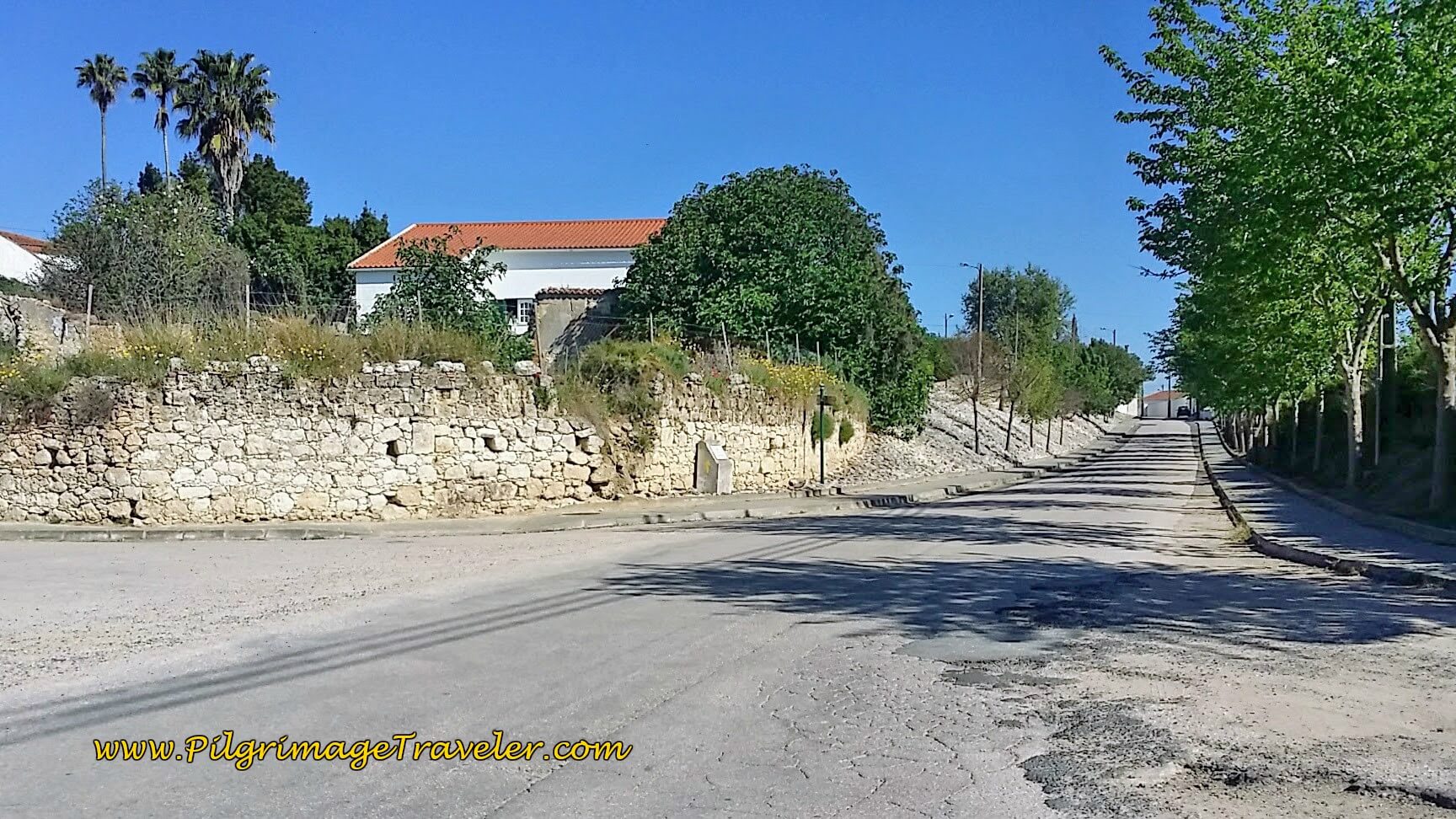 Vale de Figueira
Vale de FigueiraWe stopped at the first café we came to at 11.5 kilometers total. There are three cafés in town. The townspeople were friendly and wonderful in Vale de Figueira, at the Café Petiscos and Companhia. They taught us Portuguese and helped us learn to pronounce the next town's names!
There was even a townswoman who brought in her Calla Lilies and showed them to us. The Callas were in full bloom, almost everywhere!
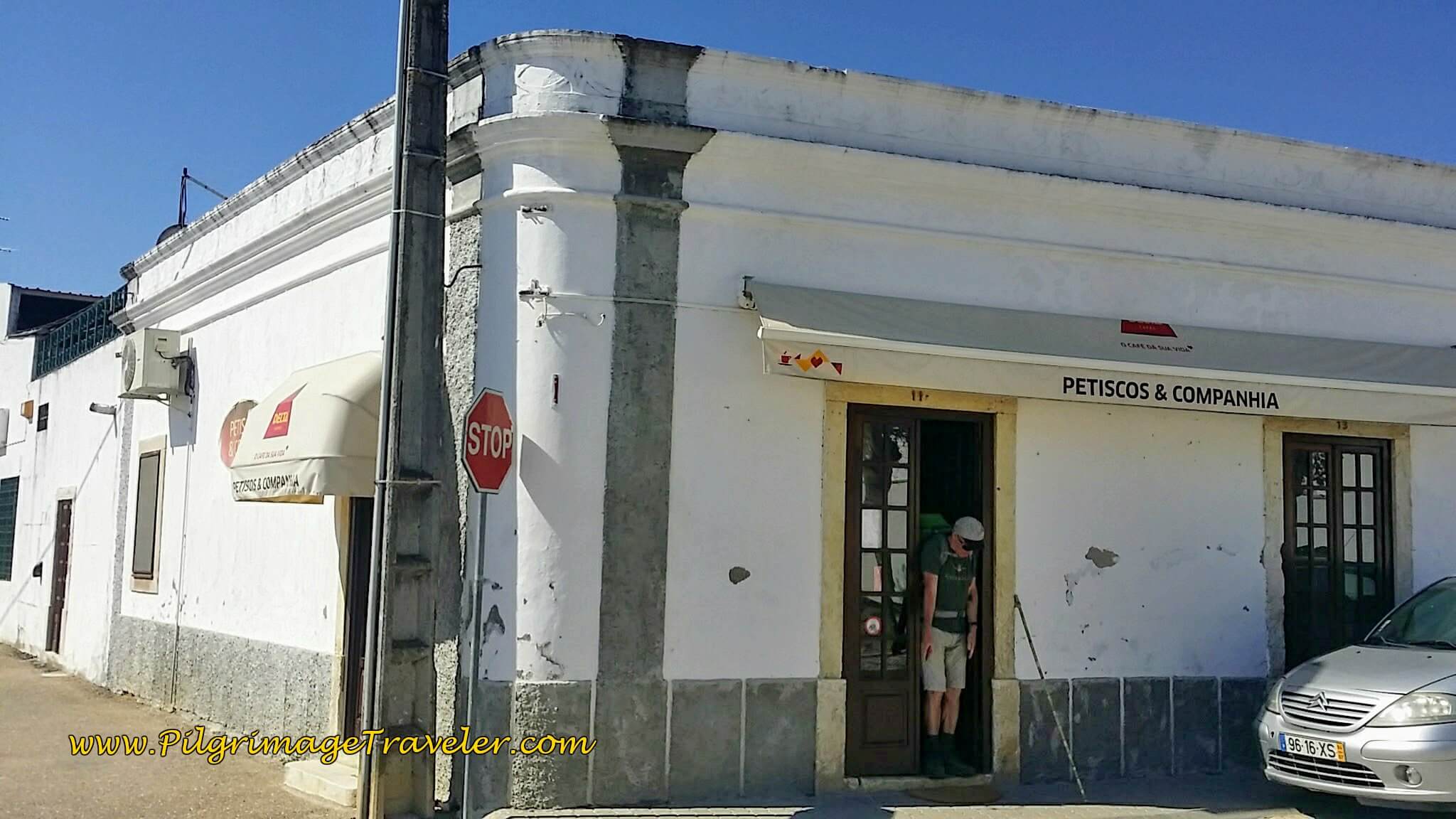 Café Petiscos and Companhia
Café Petiscos and CompanhiaIt was nice to be treated warmly in the café. The Portuguese are friendly when approached, but are a bit reserved when merely passing by.
After a nice, long break, we carried on through town, about another 200 meters until the blue Camino de Santiago sign appeared. See the photo below. You turn right here onto the Rua do Sobal.
 Turn Right at Blue Camino de Santiago Sign
Turn Right at Blue Camino de Santiago SignJust before the turn off at the blue sign, there is a small grocery store on the right, and we stopped to replenish our packs with fruit and other snacks!
If you were to stay straight, and not turn for the ongoing Camino, the brand-new and wonderful looking Casa das Laranjeiras is about ¾ kilometers down the road.
It was along this way we encountered a van load of locals, who upon recognizing us as pilgrims, enthusiastically started waving at us, and calling out "Bom Dia," or good day. I always greatly appreciate the support of the locals and this greeting was wonderful and uplifting!
We were thrilled when the main road soon turned into a lane, and we entered a lovely and shady eucalyptus forest. For those of us who have walked before, we know the eucalyptus tree is the signature tree of the Camino de Santiago, especially once you reach Galicia, the Spanish province where Santiago is located. The sight and smell of the trees lifted my spirits.
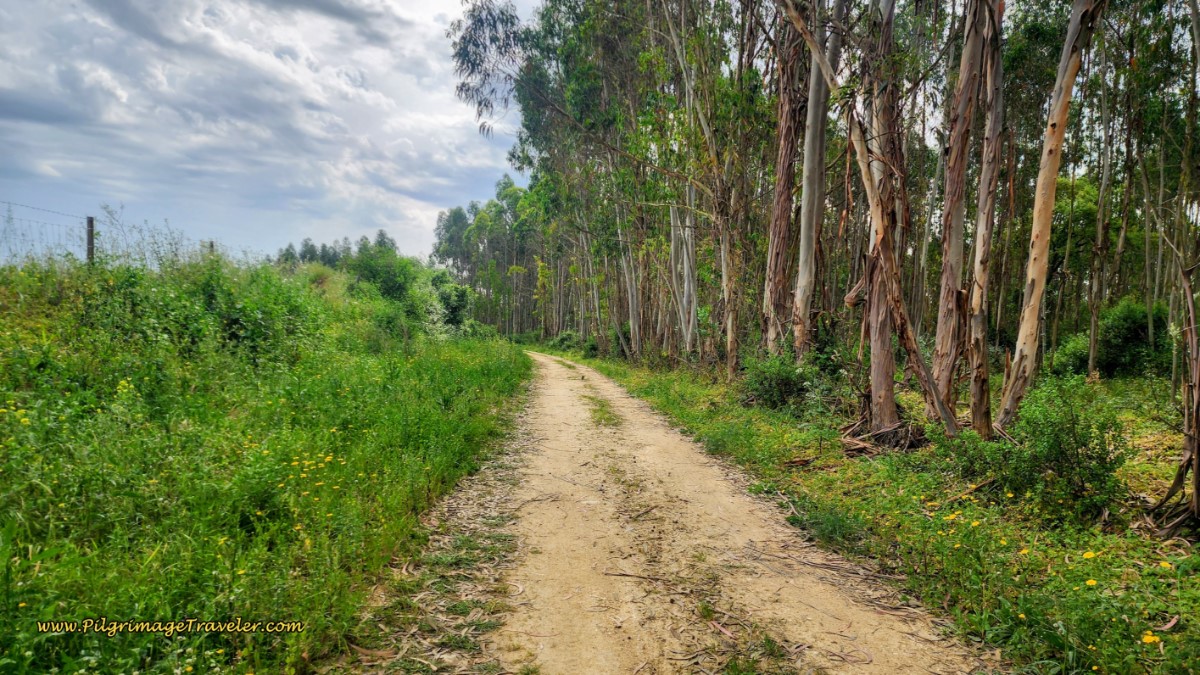 A Shady Eucalyptus Walk
A Shady Eucalyptus WalkThe very famous cork trees we encountered in this forest had waymarks. I loved this one!
Jump to Camino Portugués Stages
The lovely vineyards continued and below is one with a rose bush! How lovely is that?
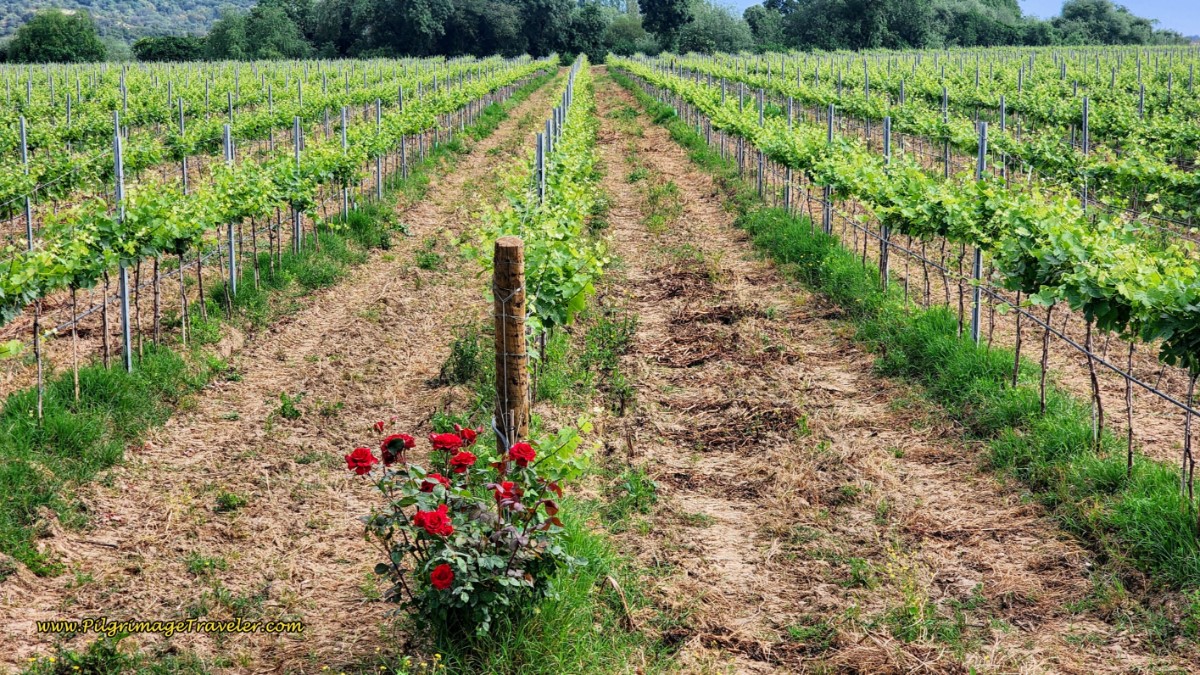 A Rose Among Vines
A Rose Among VinesThen too soon it was back to the open, hot lanes through the fields, and by mid-morning, it was now extremely hot! Up ahead in the photo below, you can see two posts, where we turned left.
 Turn Left Ahead onto Another Farm Lane
Turn Left Ahead onto Another Farm LaneThe impossibly long lanes of a lot of nothing gave us ample time and space to empty our minds and walk in a most contemplative fashion. This was my goal - walk in contemplation, however, the heat made it most difficult! We walked on, in single file, placing one hot foot in front of the other.
 Hot Lanes and Fields
Hot Lanes and FieldsThe lanes through the fields turned really rugged at times, a phenomenon that surprised me! I thought this Portuguese route would be more developed than this. I had to watch my footing and was grateful, at least for the earth instead of the pavement. I was also most grateful for my hiking poles.
 Undeveloped, Rough Lanes
Undeveloped, Rough LanesSomewhere along these lanes, I noticed that Rich had a slight limp. He was not walking as fast as he had been that morning. When I asked him about it, he stated that his right arch of his foot was hurting a bit. We pondered whether or not we should stay the night in Azinhaga (pronounced Oz-in-YA-ga) or to push on to Golegã.
After approx 6.5 kilometers from the café in Vale de Figueira we came to this intersection, below, with both an old tile waymark from the municipality of Golegã and a new post waymark. In places going forward, you will see more of these quaint old waymarks, that I appreciated.
Here you will turn left towards the hamlet of Reguengo de Alviela and Pombalinho. You have come a total of 18 kilometers at this turn.
After the turn, only 100 meters onward, you will turn to the right onto a farmer's lane. At this point, the old route used to go on straight, for a jaunt through Reguengo do Alviela, then turning right onto the N365, to enter Pombalinho. You will still see arrows pointing to the left at this intersection, and to the right for the new route!
We turned to the right and onto the new route where the Way continues through the fields, below. The field shown here, I believe is rapeseed, and the farm lanes were covered in knee-high grass the last time we passed through!
 Walking Through Deep Grass
Walking Through Deep GrassWe followed waymarks through the fields for the next 2.4 kilometers, until it turned to the right again after passing a bank of solar panels, at this intersection, pictured next. This is where the new route joins the old route from Pombalinho. As stated before, this new route shortcuts the Way by about three kilometers! Thank-you Camino planners!
 Continue on the Country Lanes
Continue on the Country LanesThere is absolutely no shade here on these back country lanes. Wear a straw hat! We were all getting funky tans, me especially on my hands, since I was wearing long sleeves. Rich was getting a rash on the back of his legs - most likely from the sun! All this, despite our slathering ourselves with sunscreen!
Rich's limp continued to worsen. The official route keeps on going on long farmers' lanes, through more gorgeous and golden rapeseed fields.
We encountered this intersection, below, just before entering town, at 22.8 kilometers total, where the Camino stays to the right. It is a full 11 kilometers on these hot lanes from Vale de Figueira to this point in Azinhaga!
 Entering Azinhaga on Day Four, Camino Portugués
Entering Azinhaga on Day Four, Camino PortuguésWe discussed our plans, and our Swiss friend stated that most likely he would stay in Azinhaga for the night. Rich and I were still sitting on the fence.
Next, look to the right, leaving the road, where the Way takes you onto a better path, by this cool and shady canal of the Rio Almonda.
Jump to Camino Portugués Stages
The Camino Breaks Our Swiss Friend in Azinhaga
Rich's limp continued to worsen. Our Swiss friend who had decided to push on with us was reaching his limit. The heat was brutal. The news reported that it was 29 degrees Celsius (84 Fahrenheit) in Lisbon that day, and people were already hitting the beach. In April.
It was 2:30 in the heat of the afternoon, and I thought it was only 6 km to Golegã from here! I was wrong.
Shortly after entering Azinhaga, our Swiss friend stated he could walk no more. He would only say, "It's too hot to walk."
Since there is no train connection in Azinhaga, we checked our options. We were already at about 23 kilometers for the day. Our friend could stay in Azinhaga. Rich felt he could keep on walking to Golegã. It was hot, indeed, but when we checked the route for the next day, we decided that we wanted to reach Tomar and have a rest day there, instead of two short days before.
Since our Swiss friend did not want to go on, but seemed to desire to stay attached to us, he said, "then we will all take a taxi to Golegã!"
I wanted to stay committed to walking the entire route, so I replied that I did not want to take a taxi, but that I wanted to walk. Our Camino friend looked at us and blinked.
We inquired of two masons, working on a house as we walked by, could they tell us how to acquire a taxi? They replied in perfect English, that there was no taxi service in Azinhaga!! We asked how far it was to Golegã, expecting to hear that it was 6 or less kilometers. They answered that it was at least 10 kilometers! We all gasped. Ten more km in this heat!! (In actuality, it is about 8 more kilometers from here to Golegã.)
I had a quick private discussion with Rich and he was OK with walking on, as I was still committed to walking the entire route. It meant more that 30 km for the day, and I thought, we'll just take it slow and get there when we get there.
We told our Swiss friend that we were going to continue to walk. Then Rich asked the mason if he knew anyone who would be willing to drive our friend to Golegã, since he could walk no more.
Without hesitation, the mason stated - my son can take you! It will be no problem! A jubilant Swiss friend said, "We can all go together to Golegã!"
We had to firmly stand our ground, that we would walk and could join him once he got to Golegã. The friendly mason said he would drop him off in the main plaza by the church, and the Camino would pass through there. We would be able to find him no problem.
Our poor Swiss friend had had enough, yet he still could not or did not want to go his own way. Our nickname, the Barnacle, was still appropriate, however, I could not blame him for not wishing to travel alone. We were his only family and he seemed truly beaten.
Quickly, a car arrived and he was whisked off to Golegã by himself. Portuguese hospitality is unparalleled on the Camino.
If you do decide to stay in Azinhaga, there is the Casa das Portas (has dormitory beds) along the N365, and the Casa de Azzancha, a few blocks west of the center of town. The Albergue de Peregrinos de Azinhaga is just beyond the church in the center of town, and also right along the N3635.
Eventually you will also walk right by the Quinta da Piedade (minimum 2-night stay) on the north side of town.
Back on the Camino, leave the pleasant riverwalk after 400 meters, when you encounter a bend to the left, and look for a set of stairs leading you back up to the street, the Rua Nova de Santo António. Follow the street north for one block, continuing on it to the left at the Y-intersection until it joins the N365, by the JV Café Central, below. There are three cafés in town, and two of them are here at this intersection.
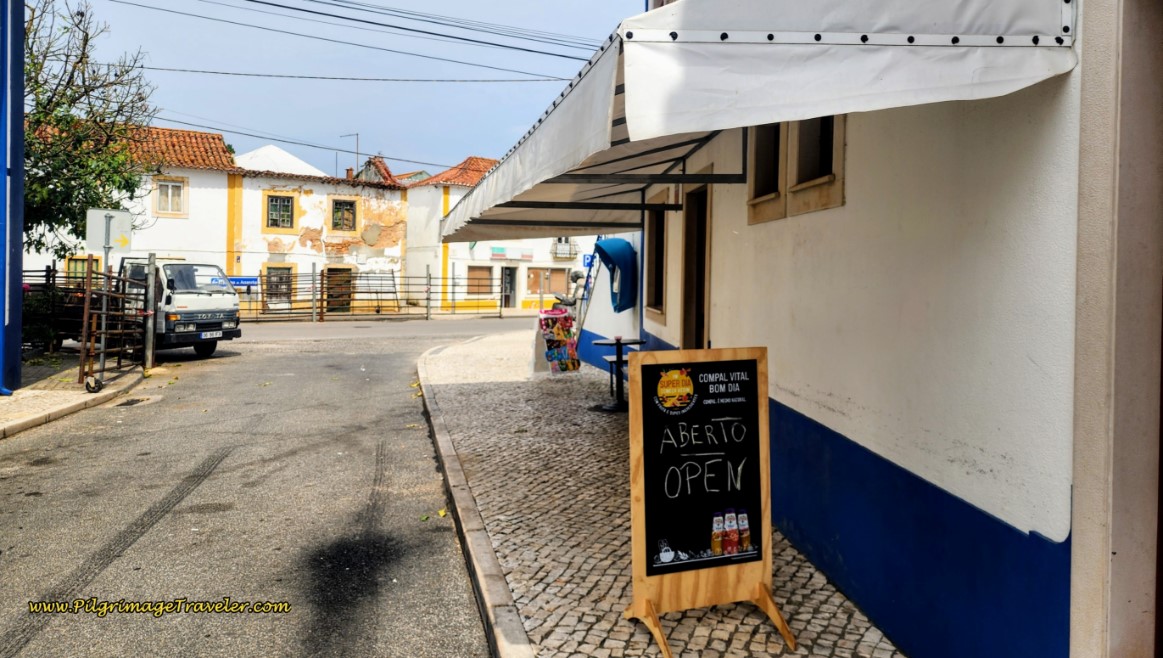 JV Café Central, Azinhaga
JV Café Central, AzinhagaAs we followed the N365 through town, Rich and I were a bit discouraged upon leaving Azinhaga and stressed over whether or not we had made the right decision. I still had some energy, but I had to dig very deep in order to go on. I felt bad about leaving the Barnacle, even though I knew this was my (our) Camino, not his.
Yet we walked onward on the N365, with the beautiful and newly redone church, the Igreja de São João da Ventosa, below, to distract us. If it were not so far off the road, and I was not so tired, I would have loved to have visited it, on day four of our Camino Portugués.
 N365 towards Golegã with Another Pilgrim
N365 towards Golegã with Another PilgrimAfter 1.5 kilometers from the center of Azinhaga, and about 25 kilometers total, we arrived in Brôa, shown below. That is the Quinta da Piedade, just after the sign.
 Walking Through Brôa
Walking Through BrôaWe continued on busy N365 after turning right in Brôa. Our progress in the heat seemed all too slow for me.
 The Dangerous Section of the N365
The Dangerous Section of the N365This stretch of pavement is very dangerous. The Portuguese drivers are very fast drivers. Initially, there is a nice walking shoulder and then for the final kilometers, there is no shoulder at all! We even had an incident where one car was passing another as they both came speeding towards us! Needless to say, we jumped off the road! Wear bright colors to be seen fully!
And finally after an exhausting final 5 kilometers, the town sign greeted us.
As we entered the town proper, a very nice monument to the Camino de Santiago also presented to us.
Shortly after the monument, the Camino turns to the right and onto the Rua de São Lourenço, then left after a few meters onto the Rua do Campo, where shortly after you arrive at the main church and the Central Plaza and Café. Here is where we joined up with our Swiss friend. He was happily quaffing beer, as we fell exhausted into the chairs beside him. I turned off the GPS at the church.
Beside being exhausted, we had no blisters, and Rich's foot was OK. It had held up. It had taken us two more hours to walk from Azinhaga to Golegã and we did not arrive until 5:30 in the afternoon.
A 28 km day had turned into 31. It was not easy! Our Swiss friend, now happy and rested, kept saying, "You are good walkers, You are strong walkers!"
Instead of staying and imbibing at the café, we walked due north along the Rua José Relvas another 400 meters and found the albergue, a private one, the Solo Duro. Our Swiss friend took this option and we secured a room in the attached Casa da Tia Guida. The place was comfortable and clean and near the center of town. Breakfast included in all options.
The proprietress of the Solo Duro was extremely friendly and helpful. She also told us of a shortcut out of town in the morning!
To find more accommodations you can click on this link. There are many of them, including two more economical places, east of the main church, the Inn Golegã, with a dormitory option and the Galagana Charm House (offers 10% discount for pilgrims at time of booking), both a few steps from the Camino, the Quartos do Lagar right along it and finally the Lusitanus, a few steps from the central square.
We cleaned up and agreed to meet and go to dinner. We had interesting and delicious Portuguese cuisine. Our Swiss friend seemed uninterested in his meal and seemed to be becoming more aloof about the Portuguese culture. I could sense the shift in his energy.
 The Igreja Matriz do Golegã
The Igreja Matriz do GolegãWhile there was not a lot to see in Golegã, we did wander into this church, with beautiful Azulejo tiles inside, and around the plaza a bit. We were surprisingly refreshed after rehydrating and cleaning up!
Lessons Learned on Day Four, Camino Portugués
Had we made the correct decision to carry on to Golegã? We will never know. We did not suffer any consequences, but may have ruined our Swiss friend's attachment to us and/or the Camino de Santiago!
I was determined to walk every step of the pilgrimage and Rich was not going to leave me to walk alone, despite a sore foot. Our persistence worked for us this time.
The idea of contemplative walking for hours on end in the heat was brutal, for me on this day. I did not talk much along the way, that is for sure, but I am not even sure what I thought about. The day was a long, hot blurr, with some breaks to eat and drink.
It was one of those days that you are extremely proud of what you were able to do and extremely happy that it was over! I will not make up anything more than what was! I chose to forget this day as soon as possible.
Salutation
May your own day four on the Camino Portugués be better planned, now that you have the knowledge of what lies ahead. May you attempt, as I, to make it a contemplative journey, one that leads you into a better way of being!
Camino Portugués Stages:
Lisbon to Porto
Senda Litoral or the Coastal Routes: Porto to Santiago
Skip to Central Route Below, for Final Days 22-25 to Santiago
Central Route: Porto to Santiago
Variante Espiritual
Please Consider Showing Your Support
Many readers contact me, Elle, to thank me for all the time and care that I have spent creating this informative website. If you have been truly blessed by my efforts, have not purchased an eBook, yet wish to contribute, I am very grateful. Thank-you!
Search This Website:
Follow Me on Pinterest:
Follow Me on Instagram:
Find the Pilgrimage Traveler on Facebook:
Like / Share this page on Facebook:
***All Banners, Amazon, Roamless and Booking.com links on this website are affiliate links. As an Amazon associate and a Booking.com associate, the Pilgrimage Traveler website will earn from qualifying purchases when you click on these links, at no cost to you. We sincerely thank-you as this is a pilgrim-supported website***
PS: Our guide books are of our own creation and we appreciate your purchase of those too!!
Shroud Yourself in Mystery, along the Via de Francesco!
Walk in the Footsteps of St. Francis, and Connect Deeply to the Saint and to Nature in the Marvelous Italian Countryside!
Recent Articles
-
Day One on the Camino Portugués, Lisbon to Alverca do Ribatejo
Apr 15, 25 08:19 PM
Our Day One on the Camino Portugués was much more beautiful and enjoyable than we had heard. -
Hiking the West Highland Way
Apr 11, 25 08:51 PM
Hiking the West Highland Way is a representation of all things Scottish, traversing 96 miles from the lowlands of Milngavie to Ft William, in the highlands. -
Way of St Francis eBook Guide (Via di San Francesco)
Apr 11, 25 08:49 PM
Our Way of St Francis eBook Guide, a digital guidebook is full of current information to assist you in finding your Way. In downloadable, digital, PDF format.
Need suggestions on what to pack for your next pilgrimage? Click Here or on the photo below!
Carbon fiber construction (not aluminum) in a trekking pole makes them ultra lightweight. We like the Z-Pole style from Black Diamond so we can hide our poles in our pack from potential thieves before getting to our albergue! There are many to choose from! (See more of our gear recommendations! )
Gregory BackPack - My Favorite Brand
Do not forget your quick-dry microfiber towel!
Booking.com
My absolute favorite book on how to be a pilgrim:

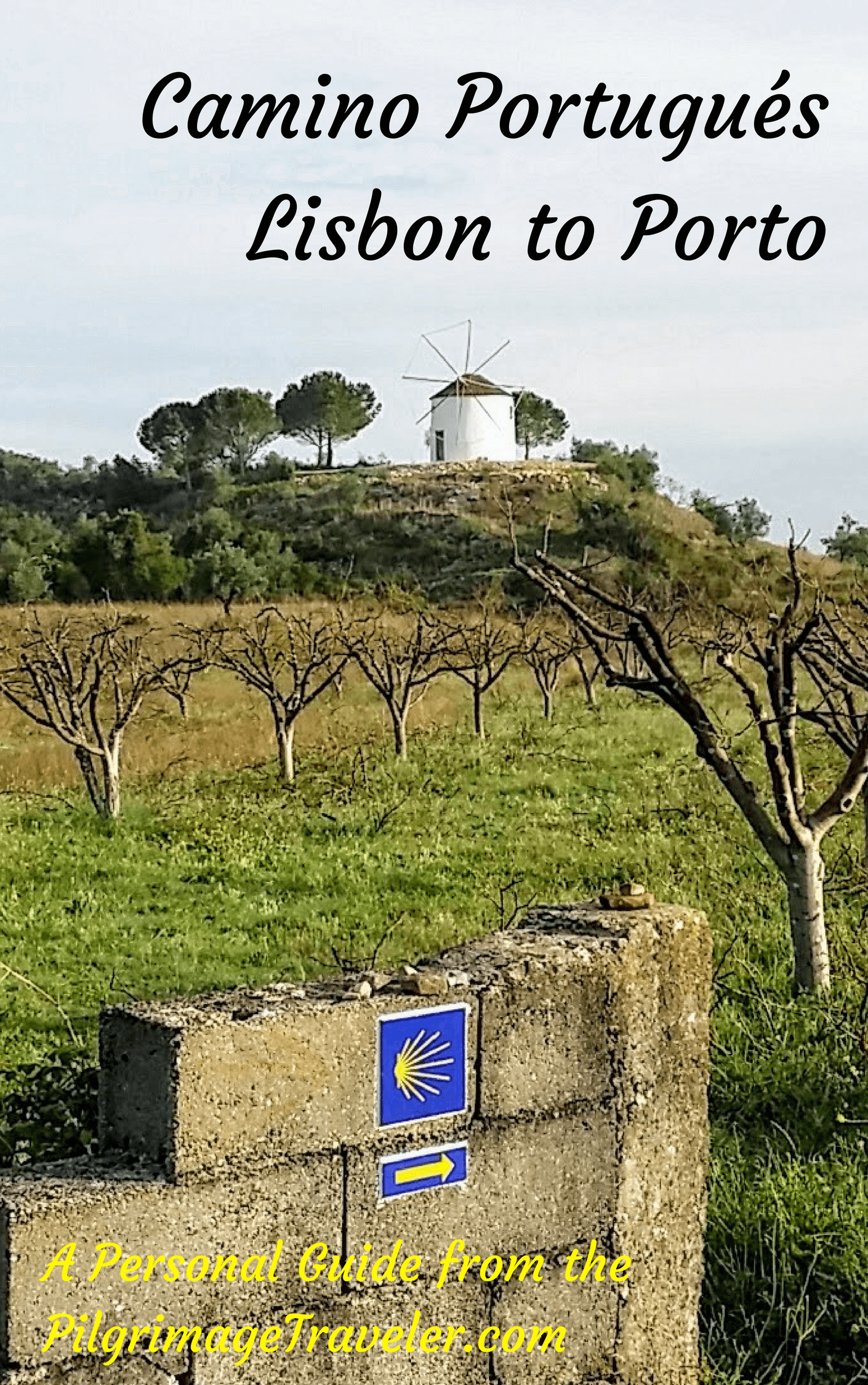



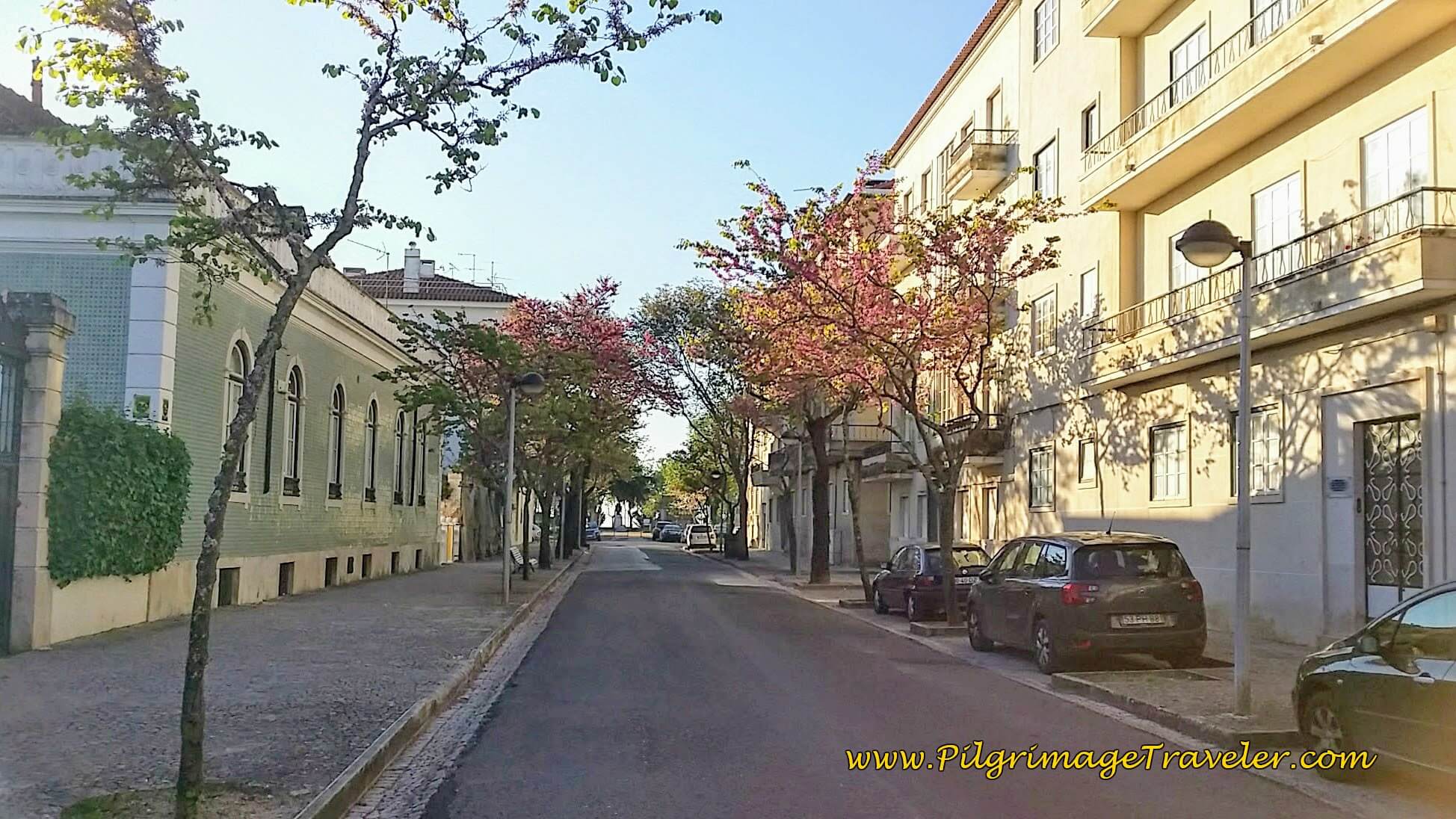






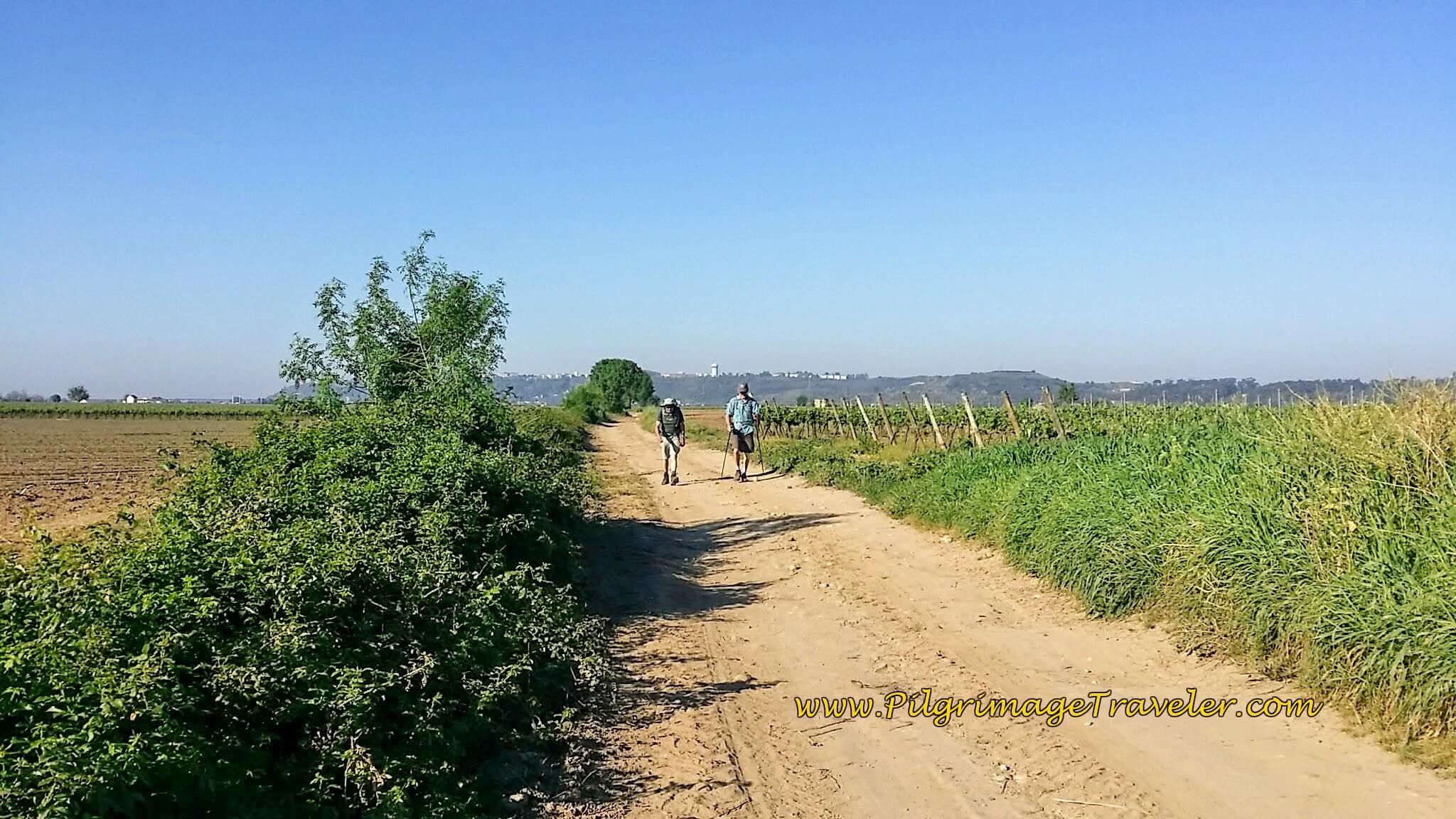

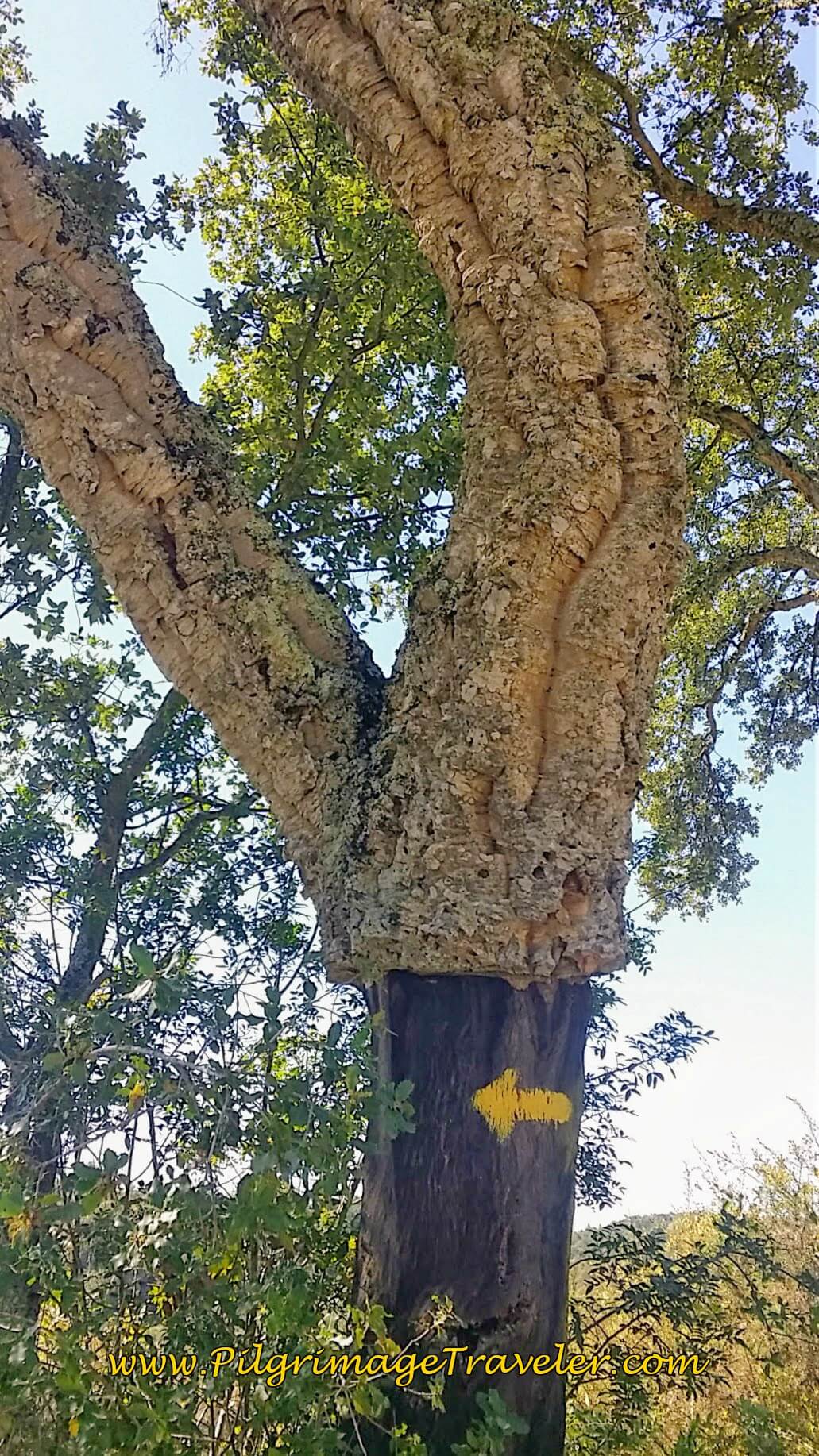

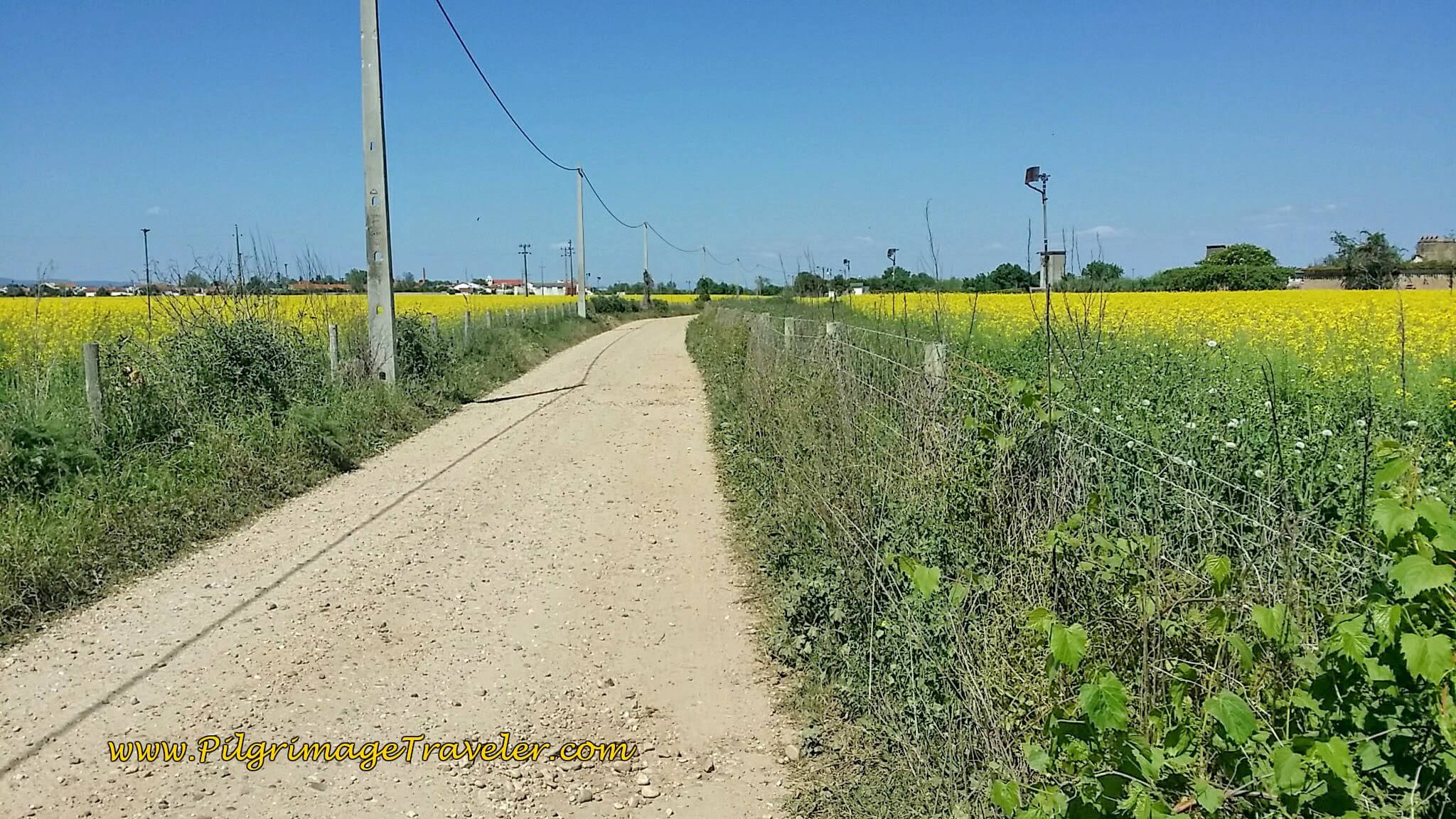







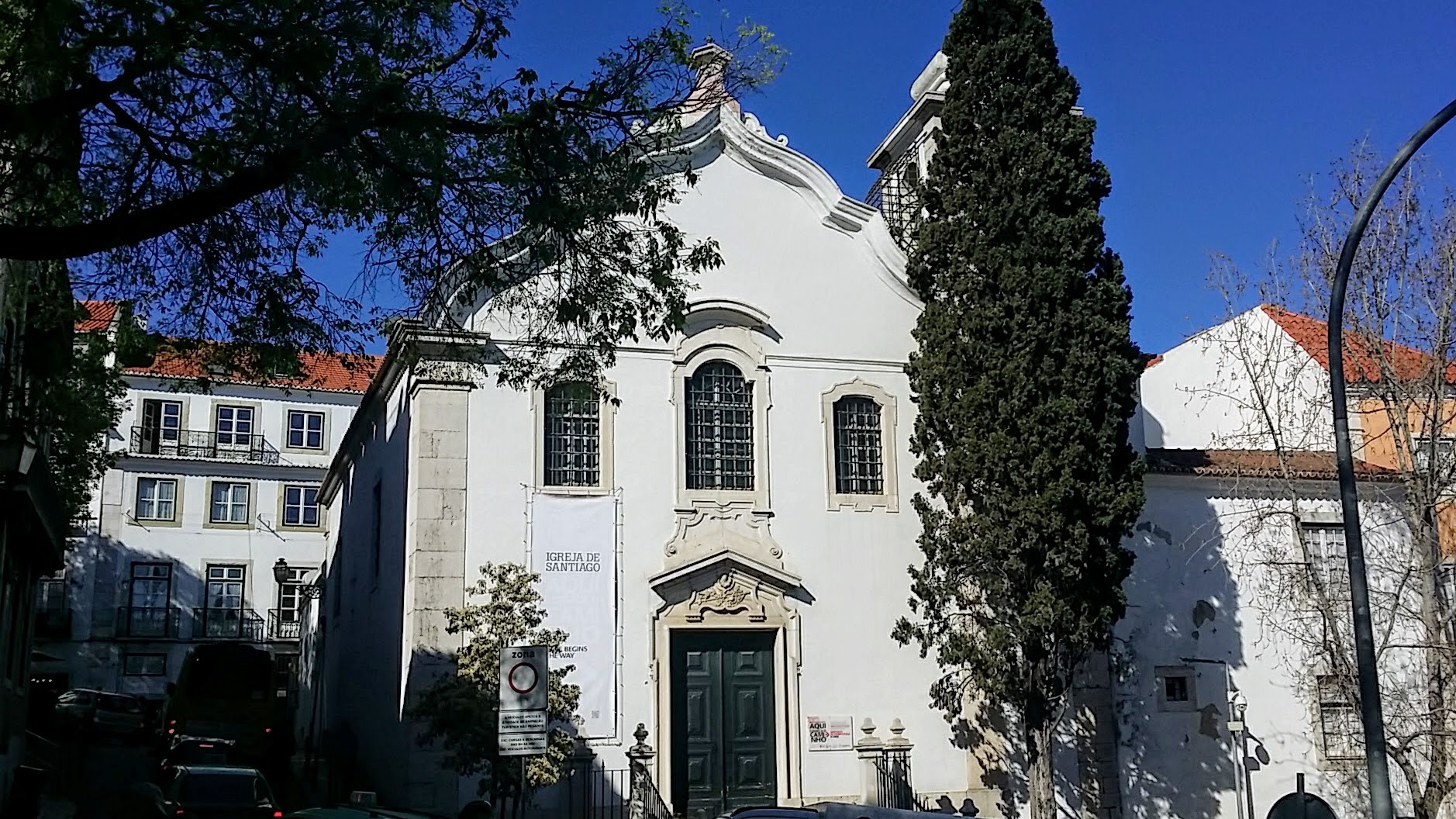

















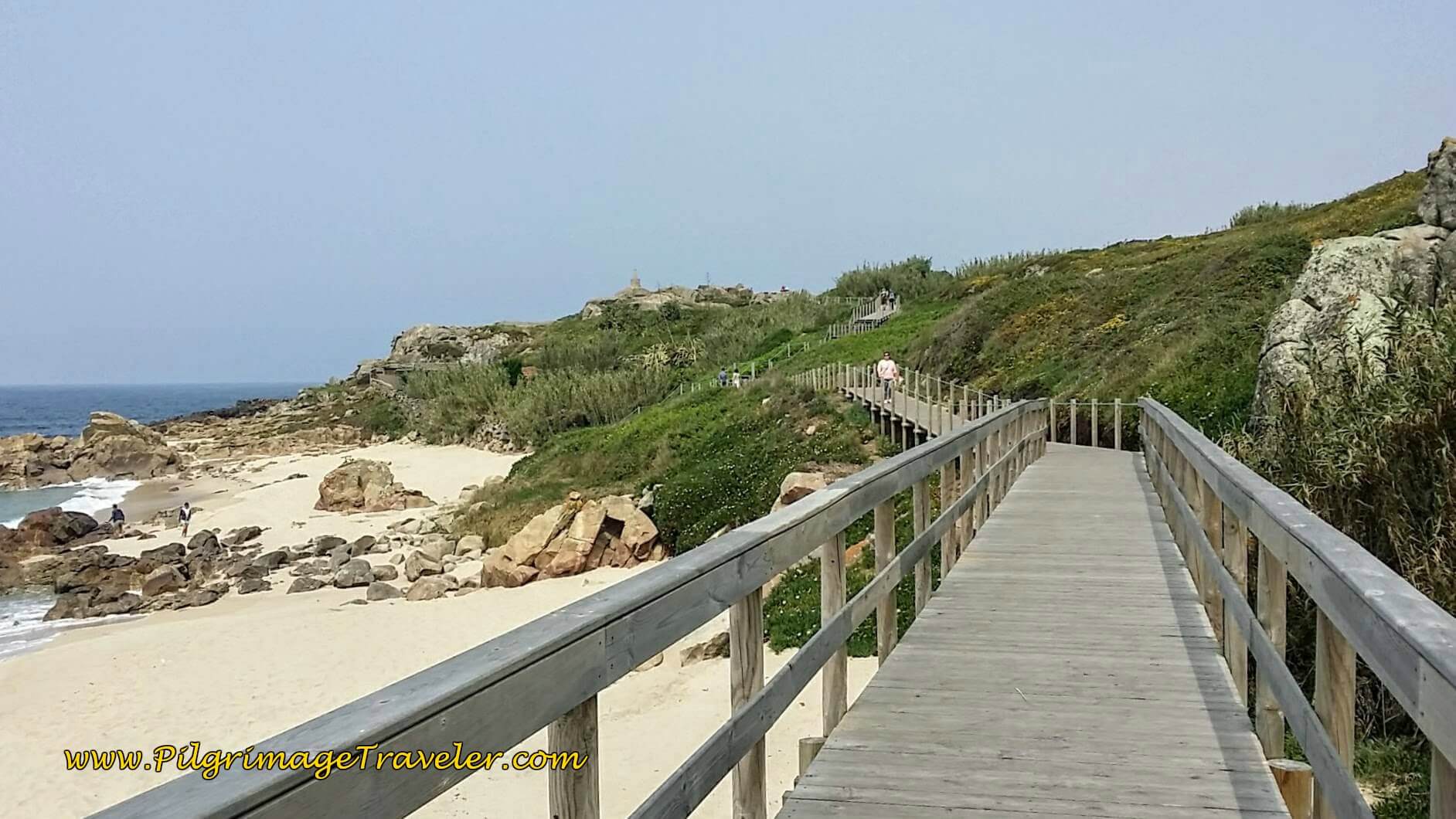












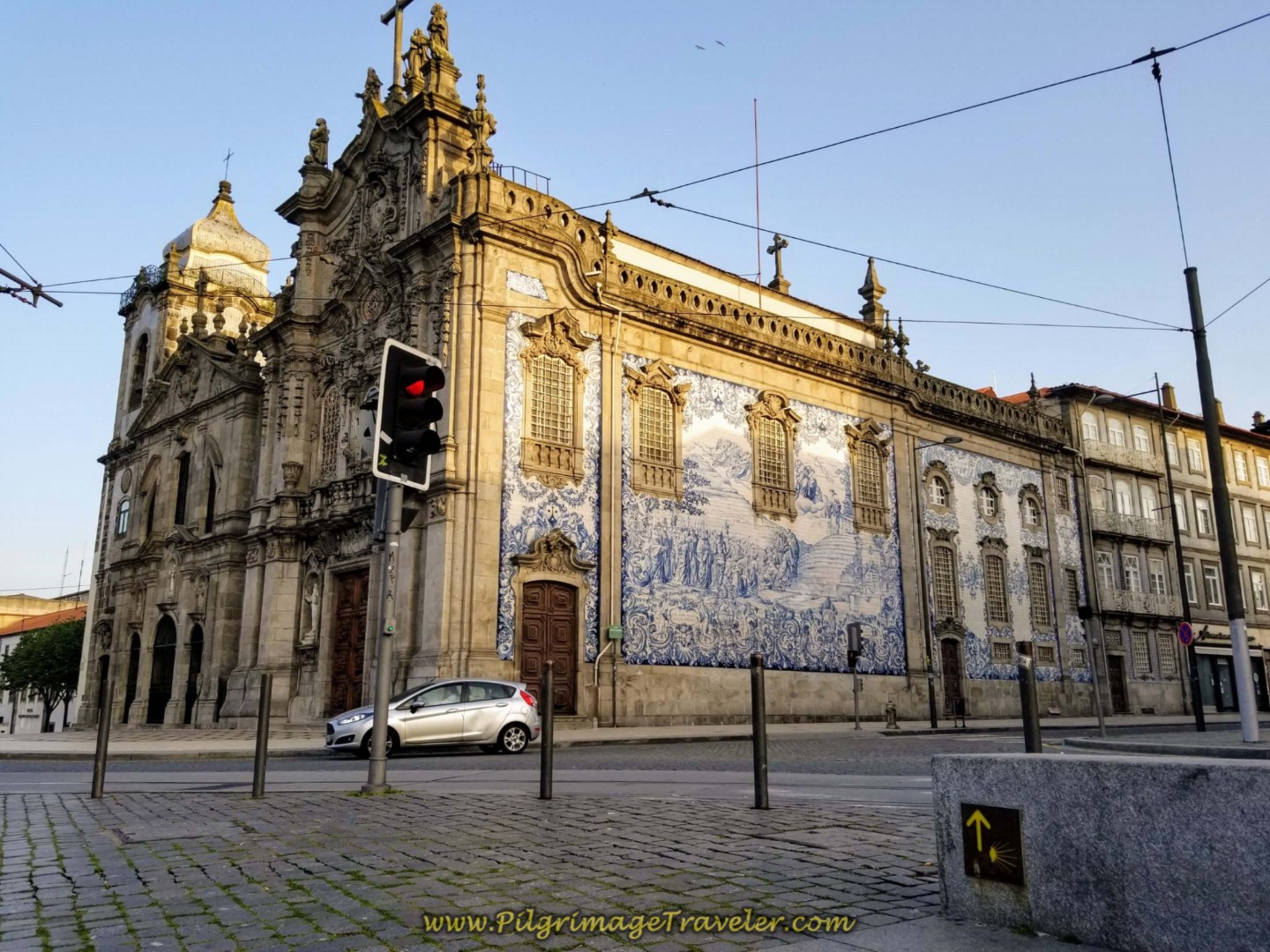











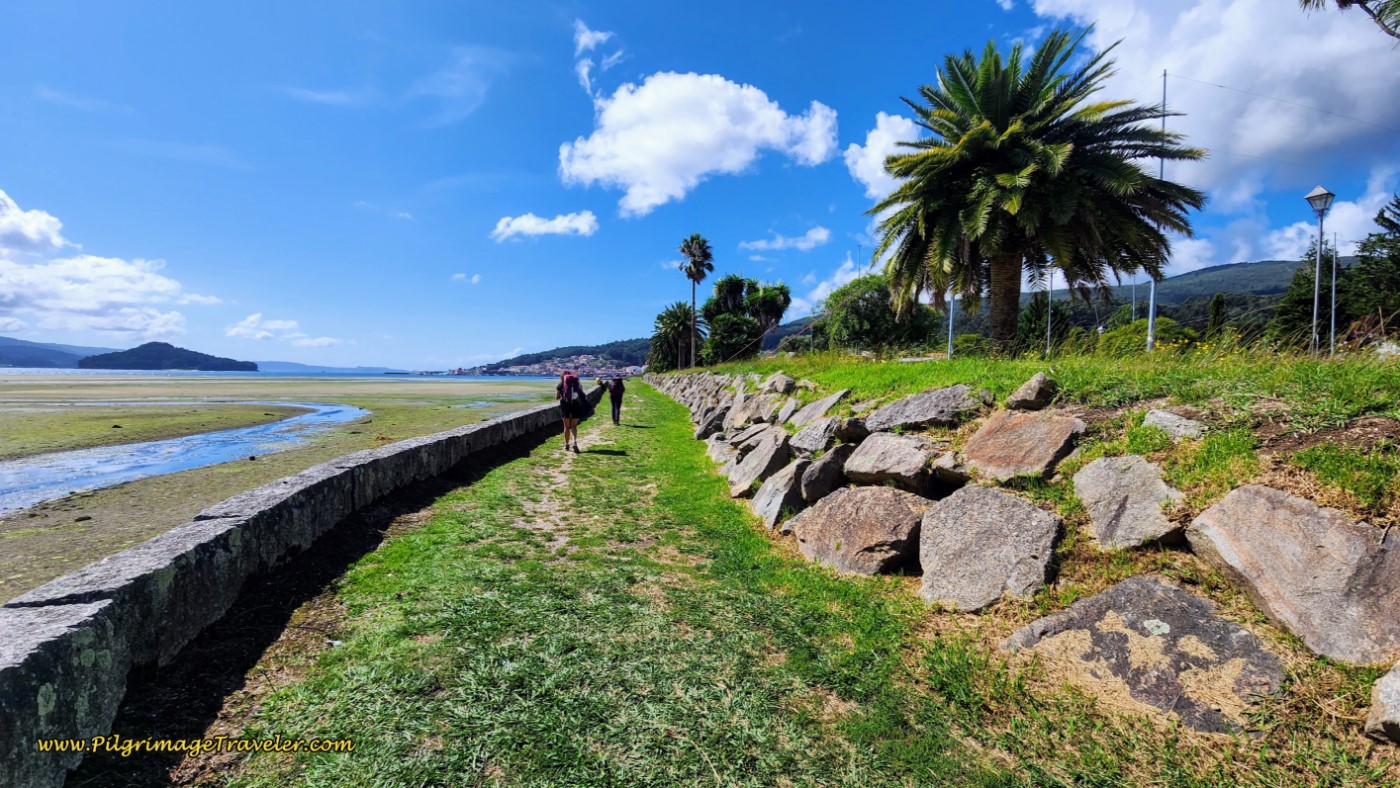







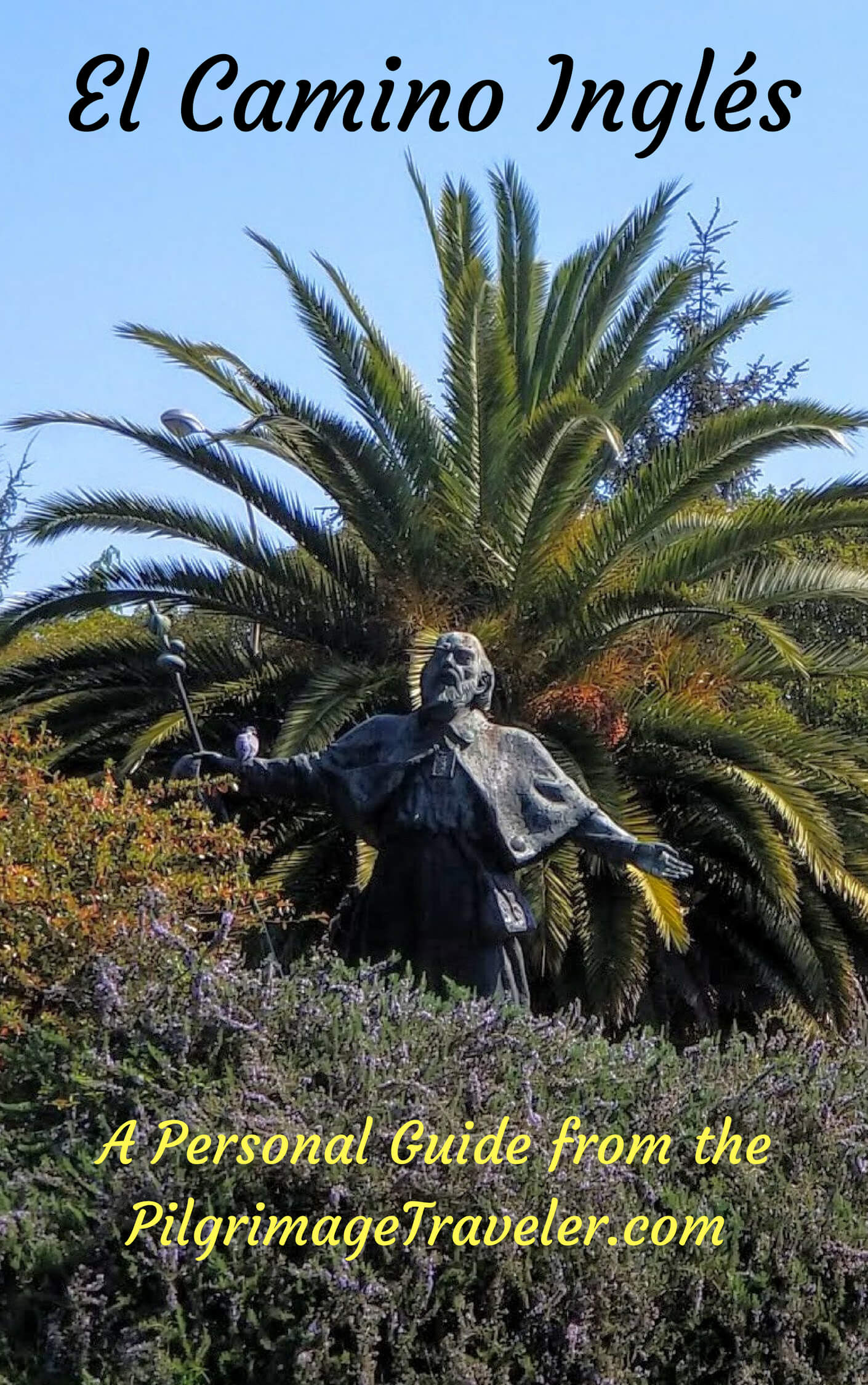




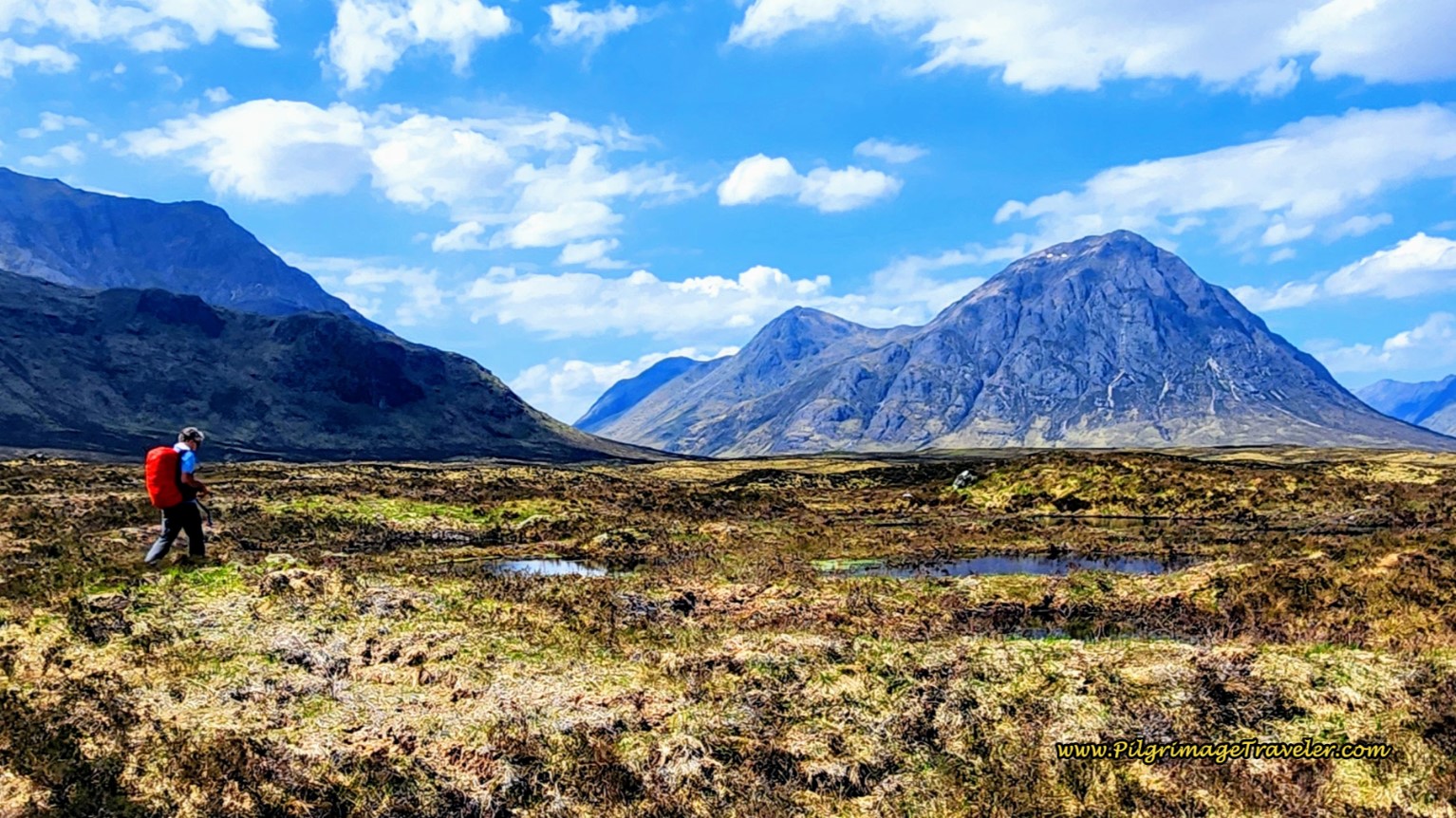
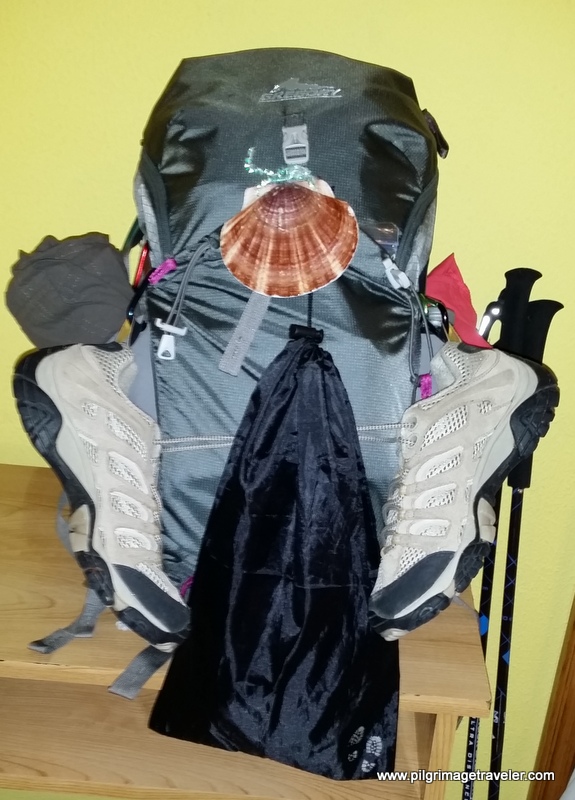



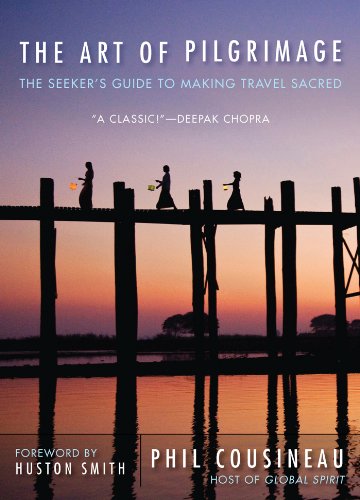


Your Opinion Matters! Comments
Have you had a similar experience, have some advice to give, or have something else you'd like to share? We would love to hear from you! Please leave us a comment in the box below.